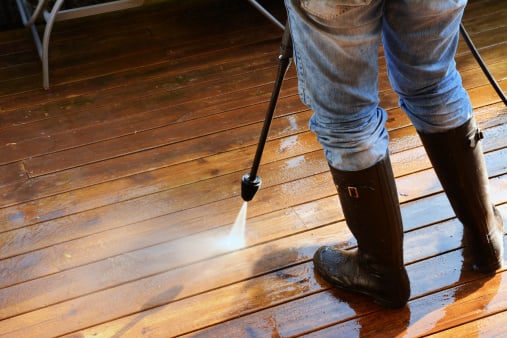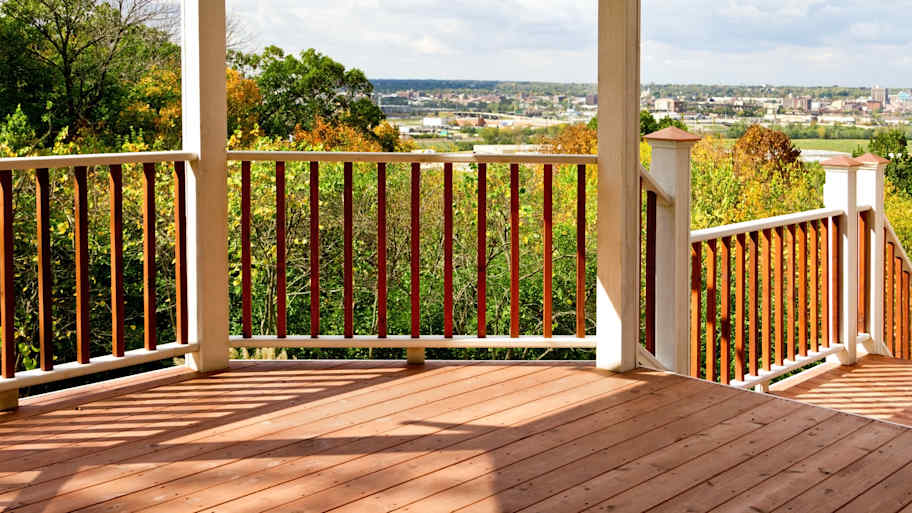
If you’re updating a deck or staircase with a modern railing, you may be wondering how much cable railing costs. We dive into the cost factors you need to know.
It ain't easy being green (but it could be easy to fix it)


The primary reason a deck turns green is mold or mildew.
In some cases, algae can play a part.
Clean the deck thoroughly with an antifungal cleaner.
Perform preventative steps to ensure the deck stays gorgeous.
A beautiful wood deck should be an absolute showstopper. It should be a warm and inviting area to hang around in. However, wood decks can sometimes turn from their natural color to a gross, greenish hue. This is likely due to mold, algae, and mildew—an unwanted trio that can ruin just about anything around the home. Luckily, there are some ways to prevent the growth of these foul substances.
It makes sense to group mold and mildew together here, as the preventative steps are essentially the same. Mold and mildew grow at a rapid pace and can turn a deck green in no time flat. These fungi thrive in damp, shaded environments and feed on organic matter, making wood an ideal host for them.
Mold is particularly frustrating, as it can pose health risks. Other than testing for mold (wear protective gear), the best way to discern whether you have a problem with mold or mildew is to look. Mildew tends to spread in a flat, powdery pattern, while mold typically appears fuzzy or slimy.
Mold remediation can pose health risks if you don’t take proper precautions. Overexposure can lead to symptoms including wheezing, red eyes, a stuffy nose, and itchy eyes or skin. We recommend wearing a respirator mask or outsourcing this project if mold exposure is a concern.
Giving the deck a thorough clean with some antifungal agents should do the trick. Start by sweeping the deck to remove any debris, like loose dirt or leaves. Next, use a commercial deck cleaner designed to eliminate mold and mildew. You can also try a DIY solution of equal parts water and white vinegar. Use a stiff-bristle brush to scrub the impacted areas, and be sure to wear protective gear.
If the deck is huge or the problem persists, use a cleaning agent and a pressure washer. If that doesn't work, it's time to call in a local mold remediation pro.

Another common culprit when decks turn green: algae. This group of photosynthetic organisms aren't quite plants, though they are certainly plant-like. Algae thrive in water but can easily survive on the surface of a moist deck. Just like mold and mildew, algae loves shaded areas. The primary danger of algae growth is that it becomes extremely slippery, so exercise caution when walking on the deck.
The steps are similar to when dealing with mold and mildew. However, algae can quickly overtake an entire deck. If that happens, start with the pressure washer and use a stiff-bristle brush and hydrogen peroxide to handle any stubborn areas. Opt for a dedicated algae cleaner that's specifically advertised as suitable for decks. If you can't find one, the same DIY solution of equal parts water and white vinegar will work. As a note, the aforementioned hydrogen peroxide won't kill the algae, but it will make it easier to remove.
Call a local deck cleaning pro if the above cleaning methods aren't working. Mold can be especially stubborn and grows quickly. The same applies to algae and, in some cases, mildew. Sometimes, they require heavy artillery, typically in the form of a knowledgeable contractor and something like a power washer. As a bonus, you could use this opportunity to clean other parts of the deck that need TLC.
An ounce of prevention is worth a pound of cure, as the saying goes. Here are some maintenance tips to ensure the green hue goes away for good.
Increase sunlight: Mold, mildew, and algae all thrive in shaded areas. If possible, increase the amount of sunlight that reaches the deck. You can't make drastic structural changes, but you can rearrange the furniture and umbrellas.
Stay on top of cleaning: These organisms thrive on organic material, so it's essential that debris is regularly removed from the deck. Give the surface regular and thorough cleanings to remove all detritus.
Keep things dry: The aforementioned terrible trio loves all things moisture. Try to keep the deck dry. You can't control nature, but you can control spills. Also, ensure that any drainage systems are functioning correctly.
Seal it up: Mold can penetrate the surface of wood, infecting the interior. This could eventually lead to rot. Give the deck a good seal to make sure that doesn't happen.
From average costs to expert advice, get all the answers you need to get your job done.

If you’re updating a deck or staircase with a modern railing, you may be wondering how much cable railing costs. We dive into the cost factors you need to know.

Flagstone patio costs vary by the size, material type, labor, and more. Stay tuned to see how much your flagstone patio could cost.
Deck repair costs depend on materials, damage you need to fix, and more. See how much it costs to replace or repair a deck in Columbus, OH.

Discover rooftop deck costs, key price factors, and ways to save. Learn what impacts rooftop deck installation costs and how to budget for your project.

If you are one of many homeowners asking, “Why are my deck boards cupping?” We get to the source of the problem and how to fix it.

Many homeowners wonder why their cedar deck is turning black. This article explains the most common causes and how to fix them.